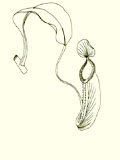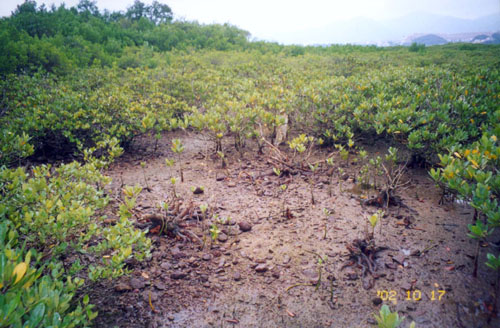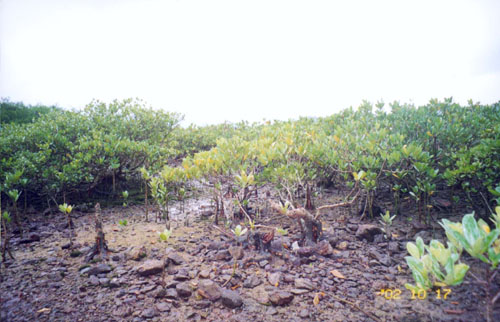

 |
 |
Miscellany (pdf)
Ting Kok: a conservation issue
by David Poon
When there is sudden rustling of grasses and the weather is calm, you may guess that there must be something moving in the grass patch but –What is it? A bird? A dog? An I I (Illegal Immigrant)? Or a porcupine?
My answer is: "It’s a lizard!"
In the morning of 18 September, while I was passing through Ting Kok village, there were sudden vigorous movements from a grass patch (near a pink house) away to my left. I thought it was a stray dog ready for an attack (!) but it turned out to be a surprise - its dark body, the typical lizard appearance, and the characteristic reptilian movement as it rushed away, made me certain that it was a Varanus lizard!
At first I believed that it was Varanus salvator – the water monitor believed to be extinct from Hong Kong’s wild places (Dudgeon and Corlett, 1994). Personal communication with Richard Corlett, Gary Ades, and Michael Lau later led me to suspect, however, that it was more likely to be an escapee of the illegally imported Bengal monitors, Varanus bengalensis (Apple Daily, 29.6.02; Ming Pao, 29.6.02).
Another "surprise" came to me two months later: on 13 October, I discovered a massive cutting of Kandelia candel at the Ting Kok mangrove. A large number of mangrove trees had been cut down and only the basal parts (roots) remained.
So what are the lessons here? First, although Bengal monitors have being designated as endangered species in their native range since 1976 (U.S. Fish and Wildlife Service), if the escapees survive and breed successfully at Ting Kok, this will be an addition to Hong Kong’s exotic species list. Second, given the apparent strong association between mangrove tree diversity and crab species richness, in particular the grapsid crabs (see Lee 1998 for review), the massive tree cutting not only resulted in a reduction of floral cover, but may also lead to a decline in crab (notably Perisesarma bidens) abundance through the loss of refuges and food sources. Also, it is uncertain whether the tree destroyers will return and convert the entire habitat into an ecological desert, like the Yi O mangrove reported by Olive Lee (2001). Ting Kok mangrove has been designated as a Site of Special Scientific Interest since 1985 (WWFHK) so, unless officially approved, any destruction or removal of fauna and flora from Ting Kok is prohibited. All in all, both the tree cutting and the importation (and the subsequent accidental release) of an endangered species (Varanus bengalensis) are equally illegal and ecologically destructive!
What happened to Ting Kok is just one of the many reported issues that demonstrate how Hong Kong’s natural environment is being frequently damaged by local citizens. Perhaps a majority of our locals do not realize that the effects of anthropogenic disturbance to our ecosystem are often, like cancers, only apparent when it is too late to recover! Finally, to reiterate, in order to protect Hong Kong’s natural environment, we need to equip ourselves with a sense of awareness as well as appreciation of nature – this is going to be an obligate matter, not a facultative one. It’s our responsibility to preserve the dwindling, yet still rich, local biodiversity for future generations, who have the right to be able appreciate it.
 |
 |
| A massive cutting of Kandelia candel at the Ting Kok mangrove. A large number of mangrove trees had been cut down and only the basal parts (roots) remained. |
Acknowledgements
Thanks Dr. Richard Corlett for forwarding my Bengal monitor sighting to Drs. Gary Ades and Michael Lau. Also thanks to Gary Ades for the newspaper cuttings.
Bibliography
Apple Daily 29.6.2002.
Dudgeon, D. & Corlett, R.T. (1994). Hills and Streams: An Ecology of Hong Kong. Hong Kong University Press, Hong Kong. 234 pp.
Lee, O.H.K.(2001). Feedback. Porcupine! 24: 4- 5.
Lee, S.Y. (1998). Ecological role of grapsid crabs in mangrove ecosystems: a review. Marine and Freshwater Research 49: 335- 343.
Ming Pao 29.6.2002
Internet Resources
World Wide Find for Nature Hong Kong Fact Sheet No. 16: Sites of Special Scientific Interest in Hong Kong.
http://www.wwf.org.hk/eng/references/index_factsheet2.html
U.S. Fishes and Wildlife Service.
http://ecos.fws.gov/servlet/SpeciesProfile?spcode=C017#status
|
|
P.19-20 |
|
Porcupine! |
 Copyright © 2000 |